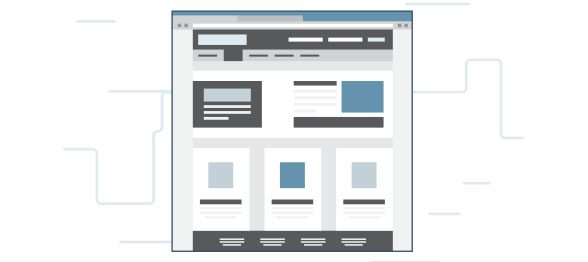Writing your accessibility policy doesn't have to take days
- Read time: 3 mins
- Tech level: medium
- Key point: you don't need to re-invent the wheel when writing your website accessibility policy
- Key tool: Accessibility Policy Generator.

This article delves into the process of creating a website accessibility policy and procedure. Since it's such an important step in the overall goal of having accessible websites, we've actually built a policy generator that will save from starting from scratch.
Why website accessibility is important to your business

People can have physical or mental conditions that are in effect a barrier to accessing some website content. With just a few simple steps when producing a website, you can remove these barriers and enable more people to access your website content.
From a business point of view, making your web marketing messages available to more people is always a good thing, and accessibility means that your marketing messages and your business offerings can be accessed by a wider group of people.
While website accessibility is not often the highest priority for large companies, it's very important in creating a website that's accessible to a wide audience of people, and not just a limited audience of people.
There are of course ethical reasons for creating accessible website content. From my experience, financial and legal reasons are usually more effective in prompting action, particularly for senior management that have an interest in reducing legal risk and increasing revenue.
Create your own policy and procedures
Examples of disabilities that might stop people accessing your content include:
- low and no vision: If someone has low or no vision, then that means that they would likely use a screen reader or assistive technology to access your content.
- limited dexterity: If someone has dexterity issues then it would be difficult to click on small links, type into small fields
- colour blindness: The colour of text and headings is important
- hard of hearing or deafness:
- and more. (The above points are just some examples of barriers to accessing website content).
How to fast track the writing of your new accessibility policy
Trying to implement accessibility within large organisations is not always easy. From my experience, the two key ingredients to achieving implementation of accessibility on websites is training and an approved accessibility policy / procedure.
Step 1 in implementing your website accessibility policy and procedure
First you need to create your new documents. This doesn't need to be an arduous process because there is an online service that can save you time and effort. The tools at Polished Procedures will save you time. See how it works.
You can have a new website accessibility policy and procedures in minutes, not days
To make this process easier for you, we’ve created an online tool that streamlines the process for you.
How the online tool works
Steps for writing your accessibility policy
If instead of using the tool mentioned above, you'd like to start from scratch, then here are the steps you'd take to create your new website accessibility policy.
Step 1: Write an opening summary that states the purpose of your policy
Help orientate people that are landing on your new policy, by giving them an informative introduction that's written in plain English. You may want to include the rational and the intended outcome of your policy.
Step 2: Define the scope of your accessibility policy
Make it clear which parts of your website will need to adhere to your accessibility policy. You may have known exception and if so, these should be documented. If your website publishes user generated content then this content should be referenced in your accessibility policy. You may also have an intranet that's separate to your public website and you'll need to document if your intranet is or is not in scope of your policy.
Step 3: Document the standards and level
You accessibility policy should indicate which level and which standards you'll be measuring your website against. If you're not sure, the most common standard is Level AA Conformance to Web Content Accessibility Guidelines 2.0.
Step 4: Define your timeline
Your accessibility policy should contain a timeline. If your website is not currently meeting the AA accessibility standards, then the next best thing is to have a timeline for when you will. You can have milestones that lead up to a AA compliance level.
Step 5: Document who does what?
To avoid duplication of effort, your internal policy should list the job titles of the people that are responsible for particular tasks relating to accessibility. If these are new tasks then HR will need to be provide advice on this.
Step 6: Create an accessibility content calendar
An accessibility audit is great for addressing the problem of accessibility problems, but needs to be followed up with a longer term plan. A content calendar means that there is a plan to continually monitor and maintain the accessibility levels of your website.
Step 7: Provide contact details
If people have questions or concerns regarding the accessibility of your website, then they should be able to make contact without too much effort. Providing relevant details will help people to get their concerns or questions responded to quickly.
Remember: it's in your best interest to make the process of contacting you simple. If website visitors can't make contact easily (or if they get no response from their enquiries), then they may choose to make a complaint to the Human Rights Commission.
Creating a policy from scratch is time consuming
It can take days and sometimes weeks to create a website policy or procedure from scratch. To save you time, we’ve created a tool that streamlines the process of publishing or producing a website accessibility procedure or policy.
Once you've completed the three simple steps in our online tool, you can then download the building blocks of a policy and procedure that will fast track you on your journey to accessible website content.
Once you've downloaded your document, you’ll just need to:
- review it
- tweak it, and then
- submit it for approval to the relevant people in your organisation.
Support from the top is critical
‘Buy-in’ from the top of your organisation is critical in achieving accessible website content. This is because once you convince senior members of your organisation to support website accessibility, the rest of the steps happens faster when compared to driving the project alone.
Framing accessibility
It seems to me that a lot of the time people with accessibility issues or disabilities are often thought of as a different group of people, but really, they have all the same desires and wants as everyone else. By this I mean, when all people go to a website, they want to
- find information quickly,
- consume information that answers their question or solves their problem, and
- not have to work unnecessarily hard in order to complete their task.
Bring your website visitors to life
Personas help bring your target audience to life. Here are some examples of personas with disabilities.
Examples of personas
 'The website visitor with a hearing impairment' persona, Bernadette
'The website visitor with a hearing impairment' persona, BernadetteThis persona of a website visitor with a hearing impairment will help you make your website more accessible and to tailor your content to the people that matter most - the actual website visitors.
 'The website visitor with a dexterity challenge' persona, Jessica
'The website visitor with a dexterity challenge' persona, JessicaThis persona of a website visitor with limited dexterity will help you target your content to the people that matter most - the actual website visitors.
How to get 'buy-in' for website accessibility
A strong and persuasive business case will help to convince your senior staff members to support you in your goal of website accessibility.
Point 1 of your business case: more website visitors
An accessible website can expand your audience.
There are new business opportunities when your marketing messages can be accessed by more people.
Focus on how accessible websites will attract more website visitors and more potential customers/clients.
Making content accessible means more people can see your offerings, and that's always a good thing from a business point of view or a marketing point of view
Point 2 of your business case: Search Engine Optimisation
A number of methods used to make your website more accessible overlap with Search Engine Optimisation (SEO) techniques. This means that when you make your website accessible, there are positive flow on effects regarding your websites ranking in search engines results. The reason for this is that Google typically likes high-quality content and high-quality website because it's referring traffic on, and Google wants to make sure that it's referring traffic on to quality content because it's their reputation at stake as well.
After all, if people stopped using Google to find information, then their business would be affected.
Examples of overlapping techniques include:
- Alternative text descriptions (alt tags) for photos are good for both SEO and for accessibility
- A descriptive link label that indicates where the link is going to take the person is helpful
- Correctly formatted headings
- Good metadata
- Marking lists as bullet points or numbered lists.
These are all quite simple steps, and as a percentage of time, implementing these improvements doesn't actually add a huge amount of time onto the production process. Just by making these simple improvements, your website can become more accessible and more search engine friendly. Once these improvements are implemented, a more thorough audit should be completed by accessibility experts such as Vision Australia.
Google will notice that you've made your website more web-friendly, and this increases your chance of getting more search engine traffic.
More on SEO techniques
Headings, for example, will communicate the level of importance of particular parts of your page. So, for example, if you've got a heading that's quite large, that signals to a sighted person that that's an important heading, and that's usually above an important piece of information. People who can't see the size will rely on the mark-up of the heading. For instance, a heading 2 will indicate that the heading is more important than a heading 3 or heading 4.
Point 3 of your business case: risk mitigation
An accessible website will drastically reduce the risk of a website visitor making a complaint to the Human Rights Commission. Rather than scrambling to respond to a complaint, it’s far better to be prepared in advance. Policies and procedures on website accessible go a long way to demonstrate your commitment to accessibly. If you're website doesn’t meet AA standards today, then the next best thing is a timeline for when your website will meet the AA level of accessibility standards.
Publicly funded organisations, such as universities and government agencies, are required to meet accessibility standards. If the public fund (even in part) your organisation, then the public have a right to access the content on your website. Since the public includes people with disabilities and impairments, these people should be able to access the content on your website. Government organisations typically need to meet the AA standard of WCAG 2.
Policies and procedures will help you if this ever does become a problem because it demonstrates that effort has already been taken to improve the accessibility of your website.
Point 4 of your business case: your company values
Most organisations will reference inclusiveness, community engagement and ethical practices in their mission statement and or company values.
An accessible website demonstrates these sentiments and a well supported accessibility policy and procedure is the first step in achieving and maintaining an accessible website.
Demonstrating that your organisation is committed to accessibility involves actually showing that you've got accessibility documents, policies and procedures already in-place.
It’s difficult to support this sentiment when your most public asset (your website) does not meet accessibility standards. An accessible website demonstrates that you're an inclusive organisation in that you are willing to take steps and make efforts to reach a wide audience and not just a limited group of people.
Point 5 of your business case: accreditation
When an organisation goes through the process of applying for accreditation, it’s critical that your organisation can demonstrate that it has a well documented accessibility policy and procedure.
Human Rights Commissions, and there's plenty of examples of private companies that have been sued for not making their website accessible to a wide group of people. For example, this article discusses the rise in law suits that relate to the accessibility of websites.
Wrapping up
Once your new accessibility policy and procedure is approved, it's important that your web editors are trained on website accessibility. Polished Pixels offers training on website best practice that includes accessibility. Another option is Vision Australia as they specialise in accessibility.









